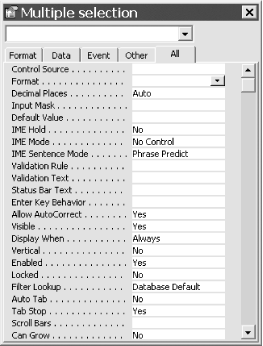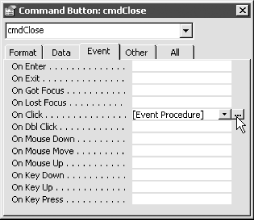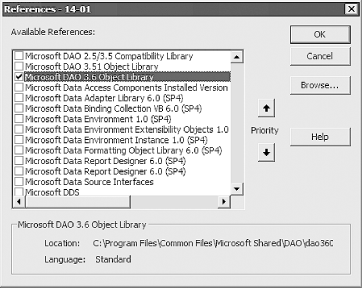| [ Team LiB ] |
|
What We Left OutTo keep this book to a reasonable length, we have made some assumptions about your skills. First and foremost, we take it for granted that you are interested in using Microsoft Access and are willing to research the basics in other resources. This isn't a reference manual or a "getting started" book, so we assume you have access to that information elsewhere. We expect that you've dabbled in creating Access objects (tables, queries, forms, reports, and pages) and that you've at least considered working with VBA (Visual Basic for Applications, the programming language included with Access). We encourage you to look in other resources for answers to routine questions, such as "What does this Option Explicit statement do?" For example, see Access Database Design & Programming, Third Edition, by Steven Roman (O'Reilly) or VB & VBA in a Nutshell by Paul Lomax (O'Reilly) To get you started, though, following are basic instructions for what you'll need in order to use the solutions in this book. For example, you'll encounter requests to "create a new event procedure." Rather than including specific steps for doing this in each case, we have gathered the most common techniques you'll need into this section. For each technique we've included a help topic name from the Access online help, so you can get more information. The procedures here are not the only way to get the desired results, but rather are single methods for achieving the required goals. How Do I Set Control Properties?In the steps for many of the solutions in this book, you'll be asked to assign properties to objects on forms or reports. This is a basic concept in creating any Access application, and you should thoroughly understand it. To assign properties to a control (or group of controls), follow these steps:
Figure P-1. The properties window shows the intersection of available properties when you've selected multiple controls
How Do I Create a New Module?VBA code is stored in containers called modules, each consisting of a single declarations section, perhaps followed by one or more procedures. There are two kinds of modules in Access: global modules and class modules. Global modules are the ones you see in the database window, once you choose the Modules tab. Class modules are stored with either a form or a report and never appear in the database window. (Actually, you can also create standalone class modules, which do appear in the database window. The use of these types of modules, which allow you to define the behavior for your own objects, is beyond the scope of this book.) There are various reasons to use one or the other of the two module types, but the most important consideration is the availability of procedures and variables. Procedures that exist in global modules can, for the most part, be called from any place in Access. Procedures that exist in a class module generally can be called only from that particular form or report and never from anywhere else in Access. You'll never have to create a form or report module, because Access creates those kinds of modules for you when you create the objects to which they're attached. To create a global module, follow these steps:
Figure P-2. Use the Tools
|
|
Programming in Access often depends on having VBA procedures react to events that occur as you interact with forms or reports. To create a VBA procedure that will react to a user event, follow these steps:
Select the appropriate object (report, form, or control) and make sure the properties window is displayed.
Choose the Event Properties page on the properties window, or just scroll down the list until you find the event property you need.
Select the property, then click the down arrow button next to the property. Select [Event Procedure] from the list of options.
Click the "..." button to the right of the event name, as shown in Figure P-7. This is the Build button, and it appears next to properties window items that have associated builders. In this case, clicking the Build button takes you to a stub for the event procedure you need to create.

Property Names Versus Event NamesThe naming of event properties, as opposed to the events themselves, is rather ambiguous in Access. The event properties, in general, have an "On" prefix, as in "OnClick" or "OnActivate." The events themselves, however, are named without the "On" prefix, as in "the Click event" or "the Activate event." We've tried to be consistent throughout the book, but there are some places where the context just doesn't indicate which is the correct usage. You'll need to be aware that with or without the "On" prefix, when the event occurs, it activates the procedure whose name is listed in the properties window for that event. When you create a new event procedure, Access creates the subroutine name, fills in the parameters that it passes, and places the subroutine into the form or report's class module. The name of the procedure is always the name of the object, followed by an underscore and the name of the event. For example, had you created the Click event procedure for the cmdClose command button, you'd see a code skeleton like this: Sub cmdClose_Click( ) End Sub |
Now follow these steps to complete the process:
If the solution asks you to enter code into the event procedure, enter it between the lines of code that Access has created for you. Usually, the code example in the solution will include the Sub and End Sub statements, so don't enter them again.
When you're done, close the module window and save the form. By saving the form or report, you also save the form's module.
When a solution asks you to place a procedure in a form or report's module that isn't directly called from an event, follow these simple steps:
With the form or report open in design mode, choose View
Code, press F7, or click on the Code button on the toolbar, as shown
in Figure P-8.

To create a new procedure, follow the steps in How Do I Create a New Module?, starting at Step 3.
Choose File Save, close the module, then save the form, or
just click on the Save icon on the toolbar.
In most cases, the solutions suggest that you import a module (or multiple modules) from the sample database for the particular solution, rather than typing in code yourself. In fact, code that isn't referenced as part of the discussion doesn't show up at all in the body of the solution. Therefore, you should count on importing modules as directed. Then follow the instructions in each solution to finish working with and studying the code.
If the solution tells you to place some code in a form's module, follow the steps in How Do I Place Code in a Form or Report's Module?. If you are instructed to place code in a global module, follow the steps in How Do I Create a New Module?. In most cases, you'll just import an existing module and won't type anything at all.
By default, new databases that you create in Access 2000 and later assume that you'll want to use ActiveX Data Objects (ADO) rather than the older set of objects for accessing data, DAO. Many of the examples in this book take advantage of DAO, because it's simpler, more consistent with earlier programming techniques, and is in general just as efficient (or more efficient) than using ADO for programming against Access data (that is, data stored in an MDB or MDE file). Both ADO and DAO are simply ActiveX/COM components provided for you by Windows and Microsoft Office, and before you can use either, you must set a reference to the appropriate type library.
If you use the projects that come with this book, you'll find that the code already includes a reference to the necessary type library so that each example works. If you create your own projects that use the techniques you find here, you may need to set a reference to the DAO type library yourself. Follow these steps to set the reference:
Within the VBA code editor, select the Tools References
menu to display the References dialog box, shown in Figure P-9.

Scroll down within the dialog box until you find the reference to Microsoft DAO, and select it.
Click OK to dismiss the dialog box.
You'll use this same technique to set a reference to any external component (including Word, Excel, PowerPoint, and Outlook, in Chapter 14), but you'll need to set a reference to DAO as shown here for many of the samples in other chapters.
|
| [ Team LiB ] |
|